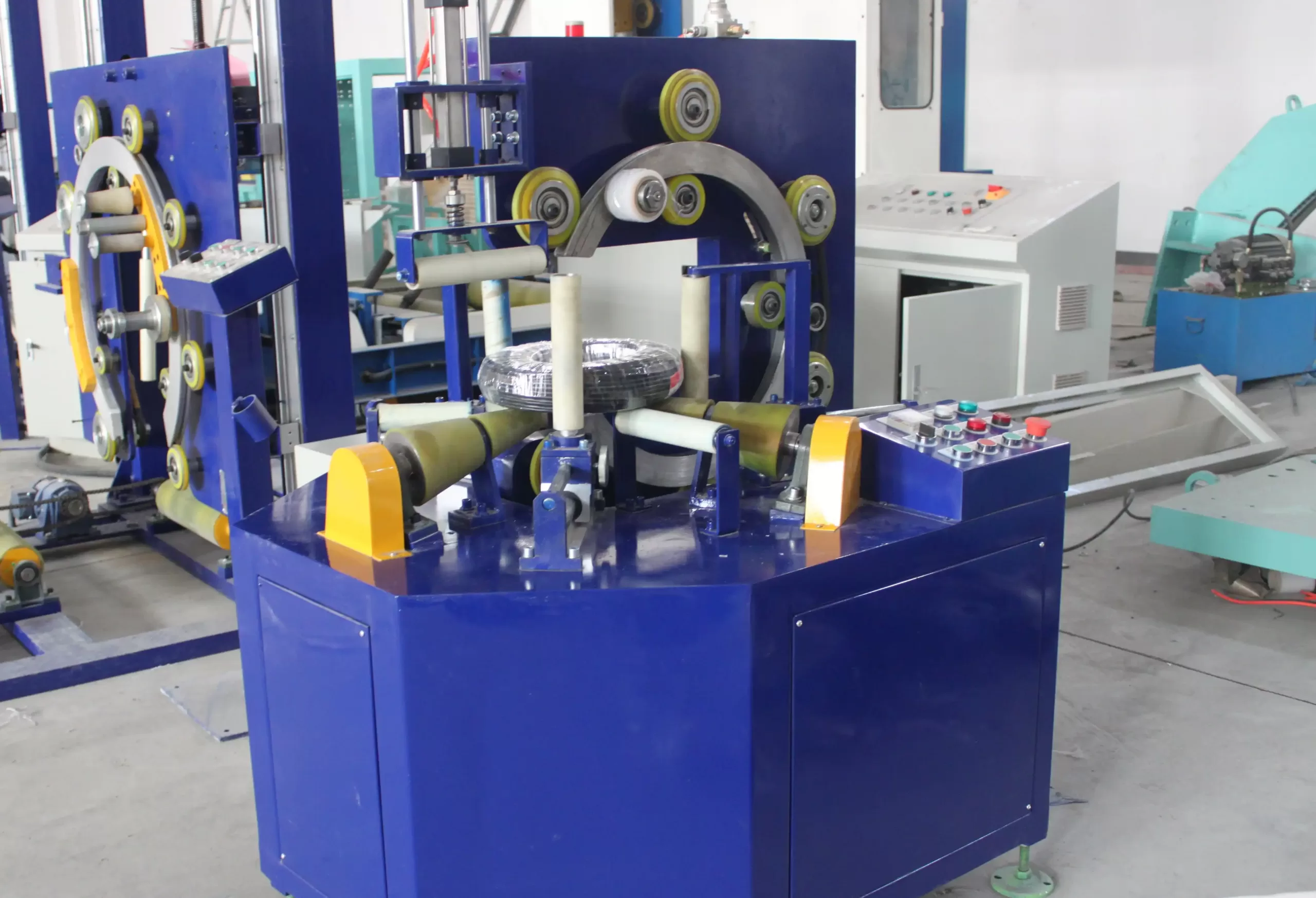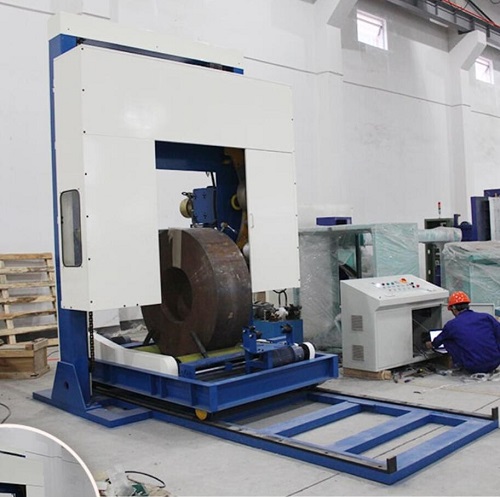1. What Are the Key Parameters for Designing a Coil Wrapping Machine?
Designing an efficient coil wrapping machine requires careful consideration of several key parameters. These parameters dictate the machine's performance, the quality of the wrap, and its suitability for different coil types and production environments. Understanding these factors is crucial for manufacturers and end-users alike.

Key parameters in designing a coil wrapping machine include coil dimensions (diameter, height, weight), wrapping material compatibility (PVC film, stretch film, paper), automation level (automatic, semi-automatic), wrapping speed, tension control, and safety features. These parameters ensure the machine meets specific application needs, providing efficient and reliable coil packaging.
Choosing the right coil wrapping machine involves evaluating various factors to optimize performance and meet production goals. Let's delve into the essential parameters that engineers and designers must consider when developing these machines.
2. Material and Coil Dimensions: The Foundation of Coil Wrapping Machine Design
The type of material being wrapped and the dimensions of the coil are fundamental parameters that significantly influence the design of a coil wrapping machine. These factors dictate the structural requirements, handling mechanisms, and overall machine configuration.
When designing a coil wrapping machine, material and coil dimensions are paramount. The machine must be engineered to handle the specific weight, size, and material properties of the coils. For instance, heavier steel coils necessitate robust frameworks and powerful motors, while delicate copper coils require precise tension control to prevent damage during wrapping. Coil dimensions like inner diameter (ID), outer diameter (OD), and height dictate the wrapping mechanism's size and range of motion, ensuring proper and secure wrapping for diverse coil specifications.

Understanding Coil Dimension Parameters
To effectively design a coil wrapping machine, a deep understanding of coil dimension parameters is essential. These parameters not only define the physical space the machine needs to accommodate but also influence the mechanics of the wrapping process.
Key Coil Dimensions and Their Impact
| Parameter | Description | Impact on Machine Design |
|---|---|---|
| Cable Diameter | Thickness of the cable or wire being coiled. | Determines the grip strength of the coiling mechanism and tension requirements during wrapping. |
| Coiling ID | Inner diameter of the coil. | Affects the size of the coil reel head and the initial point of wrapping. |
| Coiling OD | Outer diameter of the coil. | Dictates the wrapping ring's diameter and the machine's overall footprint. |
| Coiling Height | Height or width of the coil. | Influences the vertical travel range of the wrapping mechanism and film dispensing system. |
| Coil Weight | Mass of the coil. | Determines the structural strength of the machine frame, motor power, and handling capacity. |
For example, a machine designed for cable diameters ranging from 3-10mm will require adjustable tension controls to handle both thinner and thicker cables without causing damage or loose wraps. Similarly, a machine intended for coiling ODs from 200-400mm must have a wrapping arm or ring capable of expanding and contracting within this range to ensure consistent film overlap and secure packaging. The coil weight parameter is critical for selecting appropriate motors and structural materials; machines handling steel coils weighing up to 3000kg will need significantly more robust components than those designed for lighter plastic or rubber hoses.
3. Automation and Operational Parameters for Efficient Wrapping
Automation level and operational parameters are critical for maximizing the efficiency and productivity of a coil wrapping machine. These parameters define how the machine functions, the degree of human intervention required, and the overall throughput it can achieve.
Automation and operational parameters are crucial in coil wrapping machine design for achieving desired efficiency and output. The level of automation, ranging from manual to fully automatic, dictates labor requirements and production speed. Key operational parameters include wrapping speed, line speed, and the control system (PLC, HMI). Automatic machines minimize manual handling, increasing speed and consistency, while features like programmable settings and error detection enhance operational reliability and reduce downtime.

Optimizing Operational Parameters for Coil Wrapping Machines
To optimize the operational efficiency of a coil wrapping machine, several key parameters must be carefully considered and configured. These parameters directly impact the machine's speed, accuracy, and overall productivity.
Key Operational Parameters and Their Optimization
-
Automation Level (Manual, Semi-Automatic, Automatic): Choosing the right level of automation is crucial. Automatic machines like the EM-CF400 offer features such as PLC & HMI control, auto cutting, and automatic positioning, reducing manual labor and increasing throughput. Semi-automatic options may be suitable for lower volume production, while manual machines require significant operator involvement and are typically less efficient.
-
Coiling Speed: Measured in coils per minute, coiling speed directly impacts production rate. The EM-CF400 achieves 2-2.5 coils/min. Higher speeds can be beneficial but must be balanced with wrap quality and material integrity.
-
Line Speed: Expressed in meters per minute (m/min), line speed refers to the speed at which the material moves through the machine. A high line speed, like the 200m/min mentioned for some machines, indicates a faster overall process, particularly when integrated into a production line.
-
Control System (PLC & HMI): Programmable Logic Controllers (PLC) and Human-Machine Interfaces (HMI) are essential for automated operation. They allow for parameter setting, program storage (like saving 99 coil sizes), and real-time monitoring. Touchscreen HMIs, as featured in some machines, simplify operation and data input.
-
Tension Control: Consistent tension is vital to prevent coil deformation and ensure a secure wrap. Tension control systems, often pneumatically or servo-motor driven, maintain proper film tension throughout the wrapping cycle.
-
Meter Counter Accuracy: For applications requiring precise coil lengths, a highly accurate meter counter is necessary. A counter with 0.01m resolution up to 500m, as specified in the technical parameters, ensures accurate length measurement and cutting.
-
Error Detection and Alarms: Automatic error detection with indicator alarms minimizes downtime. These systems can detect issues like material jams, film breaks, or mechanical faults, alerting operators to address problems quickly.
By carefully selecting and optimizing these operational parameters, manufacturers can ensure their coil wrapping machines operate at peak efficiency, delivering high-quality wraps with minimal waste and labor.
4. Wrapping Process Parameters: Ensuring Wrap Quality and Material Integrity
The parameters governing the wrapping process are crucial for achieving a secure, protective, and aesthetically pleasing wrap. These parameters dictate how the wrapping material is applied, the degree of overlap, and the overall integrity of the final package.
Wrapping process parameters are essential for determining the quality and effectiveness of coil packaging. Key parameters include wrapping material type (stretch film, PVC, paper), overlap rate, film tension, and wrapping speed. Selecting the right combination ensures proper protection against dust, moisture, and damage during transit and storage, while maintaining package integrity and appearance.

Fine-Tuning Wrapping Parameters for Optimal Coil Protection
Achieving optimal coil protection and package integrity requires careful adjustment of wrapping process parameters. These parameters determine the effectiveness of the wrapping in safeguarding the coil from environmental factors and physical damage.
Key Wrapping Process Parameters and Their Optimization
| Parameter | Description | Impact on Wrap Quality and Protection |
|---|---|---|
| Wrapping Material | Type of film or material used (e.g., PVC film, stretch film, paper, knit tape). | Determines the level of protection against moisture, dust, and physical impact. Stretch film offers conformability and load stability, while PVC film may provide better puncture resistance. |
| Overlap Rate | Percentage of overlap between film layers. | Higher overlap rates increase wrap strength and moisture resistance but also increase material consumption. Adjustable overlap (20%-90%) allows customization based on protection needs. |
| Film Tension | Force applied to the wrapping film during application. | Proper tension ensures a tight, secure wrap without deforming the coil. Adjustable tension control is crucial for different materials and coil types. |
| Wrapping Speed | Speed at which the wrapping arm or ring rotates around the coil. | Affects throughput and film consumption. Higher speeds may require advanced tension control to maintain wrap quality. |
| Film Layers/Wraps | Number of times the coil is wrapped. | More layers increase protection and stability but also increase material usage and cycle time. |
For instance, using machine-grade PVC film roll as a wrapping material, as specified for the EM-CF400, ensures compatibility with the machine's wrapping mechanism and provides adequate protection for cable coils. The film roll size parameters (ID 75mm, OD 240mm, Width 40mm) ensure proper fit and feeding within the machine. Adjusting the overlap rate allows tailoring the wrap to specific environmental conditions; a higher overlap rate (e.g., 90%) is preferable for coils requiring maximum moisture protection, while a lower rate (e.g., 20%) might suffice for indoor storage. Precise film tension control prevents film breakage at higher wrapping speeds and ensures that delicate coils are not crushed or deformed during the wrapping process.
5. Safety and Compliance Parameters
Safety and compliance parameters are non-negotiable aspects of coil wrapping machine design. These parameters ensure operator safety, machine reliability, and adherence to industry standards and regulations.

Safety and compliance are paramount in coil wrapping machine design. Machines must incorporate safety features like emergency stops, safety guards, and overload protection to ensure operator well-being and prevent accidents. Compliance with international standards like CE guidelines is essential for market access and demonstrates adherence to recognized safety and performance benchmarks. User-friendly interfaces and clear parameter settings also contribute to safer and more efficient operation.
Ensuring safety and regulatory compliance is a critical parameter in the design and operation of coil wrapping machines. Manufacturers must prioritize operator safety through features like emergency stops, safety interlocks, and protective guarding. Compliance with international standards such as CE guidelines is not only a regulatory requirement but also a testament to the machine's quality and safety. Furthermore, integrating user-friendly controls and clear parameter settings enhances operational safety by reducing the potential for errors and accidents.
Conclusion
Designing a coil wrapping machine effectively requires a holistic approach, considering the interplay of material dimensions, automation needs, wrapping process requirements, and stringent safety standards. By carefully evaluating and optimizing these key parameters, manufacturers can create machines that are not only efficient and productive but also safe, reliable, and compliant with industry best practices. This ensures that the coil wrapping machine meets the diverse needs of various industries, providing robust and dependable packaging solutions.